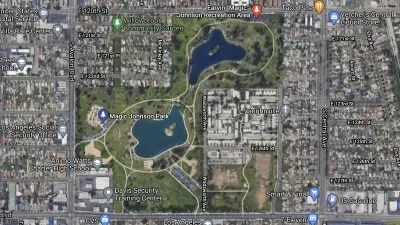Several cities are using mobile park and recreation services to augment existing parks and fill gaps in parks. LA County parks planner Clement Lau describes a sampling of mobile programs.
Many neighborhoods are park-starved, which undermines the health of their residents and the development of their children. Focusing only on permanent land-based park space ignores current needs. Actual open space parks can take a decade or more to put into place. Clement Lau, a Los Angeles County planner writes about a nimble approach adopted by several cities. These cities provide park and recreation services to underserved neighborhoods and populations by going mobile. While not intended replace real parks, this approach can mitigate the absence of parks before the root problem is fixed. The cities implementing such an approach include New York; San Francisco; Los Angeles; Cape Coral, Florida; and Boise, Idaho. The services are provided either as pop-up events, by mobile van, or scheduled programming. Services vary widely and can include hard goods like skateboard ramps, soccer goals, and basketball hoops, or soft goods like yoga classes, coaches, and volunteers to teach and play sports with children, and registration for camps. For example, writes Lau:
The City of Los Angeles Department of Recreation and Parks is planning to launch a mobile recreation program to bring a variety of outdoor activities to children and families in under-served communities. Each mobile recreation vehicle will provide differently themed activities ranging from sports to drama and dance to STEM activities. The program will commence on the weekends at four elementary schools in high park need areas.
For more detailed information on how cities are filling the gaps in parks, please see the source article.
FULL STORY: Meeting Park Needs Through Mobile Recreation

Planetizen Federal Action Tracker
A weekly monitor of how Trump’s orders and actions are impacting planners and planning in America.

Maui's Vacation Rental Debate Turns Ugly
Verbal attacks, misinformation campaigns and fistfights plague a high-stakes debate to convert thousands of vacation rentals into long-term housing.

San Francisco Suspends Traffic Calming Amidst Record Deaths
Citing “a challenging fiscal landscape,” the city will cease the program on the heels of 42 traffic deaths, including 24 pedestrians.

Amtrak Rolls Out New Orleans to Alabama “Mardi Gras” Train
The new service will operate morning and evening departures between Mobile and New Orleans.

The Subversive Car-Free Guide to Trump's Great American Road Trip
Car-free ways to access Chicagoland’s best tourist attractions.

San Antonio and Austin are Fusing Into one Massive Megaregion
The region spanning the two central Texas cities is growing fast, posing challenges for local infrastructure and water supplies.
Urban Design for Planners 1: Software Tools
This six-course series explores essential urban design concepts using open source software and equips planners with the tools they need to participate fully in the urban design process.
Planning for Universal Design
Learn the tools for implementing Universal Design in planning regulations.
Heyer Gruel & Associates PA
JM Goldson LLC
Custer County Colorado
City of Camden Redevelopment Agency
City of Astoria
Transportation Research & Education Center (TREC) at Portland State University
Jefferson Parish Government
Camden Redevelopment Agency
City of Claremont





























